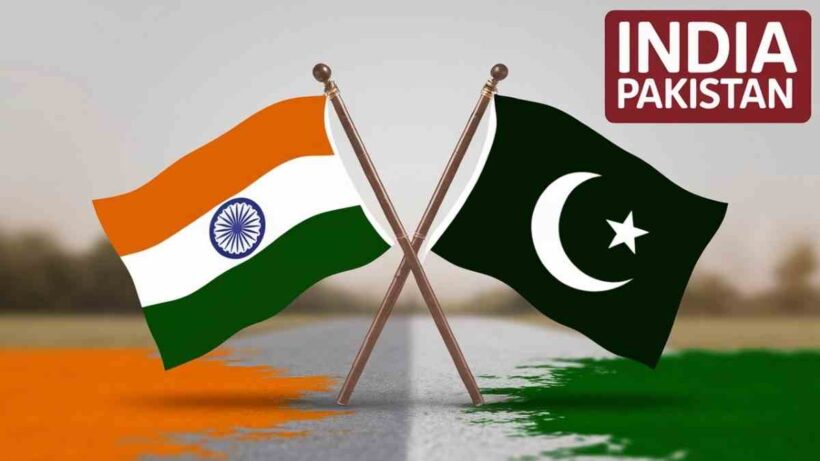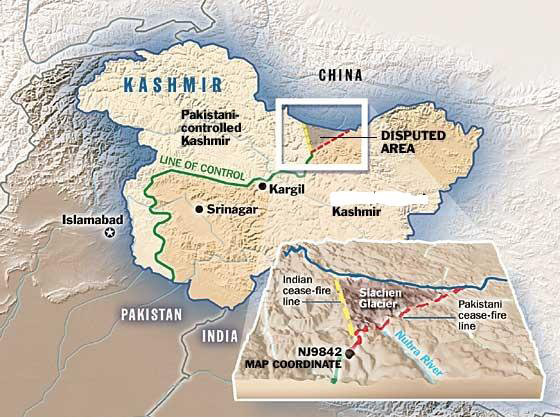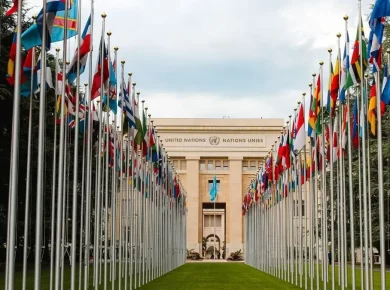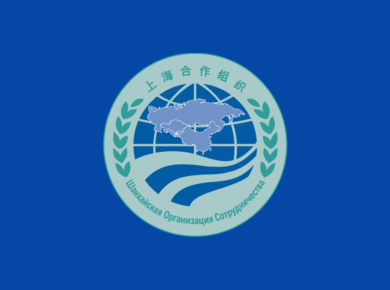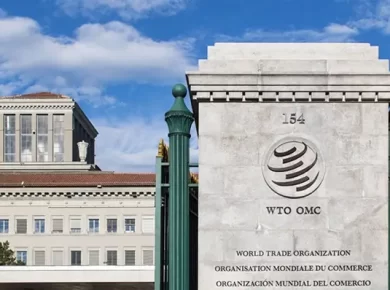India Pakistan Relations
Hindu ruler Hari Singh tried to negotiate with India & Pak to have an independent status for his state. Since majority population of the state was Muslim, the Pakistan thought Kashmir ‘belonged’ to them.
On 15th August Harisingh offered standstill agreement with both countries which allowed the free movement of people & goods. Pakistan signed the agreement but India didn’t. Pakistan became impatient & started violating standstill agreement. 24th October Hari Singh demanded military assistance from India. Mountbatten pointed out that under international law India can send its troops only after state signs a formal instrument of accession – on 26th Oct Maharaja signed instrument of accession – ratified in 1954.
On 27th Oct. morning nearly 100 planes airlifted men and weapons to Srinagar. Pakistan army left the main valley region but continue to occupy a large chunk of territory of Gilgit, Baltistan region – Pak occupied Kashmir.
At the same time India lodged complaint against Pakistan for their illegal actions in UN. Instead of getting justice at UN, Western powers backed Pakistan. India also accepted UN resolution on ceasefire in spite of its advantageous position and agreed for plebiscite in Kashmir, which laid down two conditions for holding plebiscite –
- Pak should withdraw its forces from the state of J&K
- The authority of the Srinagar administration should be restored over the whole state
- Above mentioned first conditions was never fulfilled, so there was no plebiscite there.
- Meanwhile J&K participated in India’s general elections and then the talk of plebiscite remained irrelevant.
Kashmir conflict didn’t prevent cooperation between governments of India & Pak. Both the governments worked together to restore the abducted women to their original families, a long term dispute of river water sharing was resolved – with world Bank’s mediation and India-Pakistan Indus Water Treaty was signed by Nehru and General Ayub Khan in 1960.
Also read: India China Relations and India Japan Relations
India Pakistan Wars
1965 India Pakistan War
- Pakistan launched armed attacks in the Rann of Kutch area of Gujarat, later it launched bigger offensive in J & K in 1965.
- Pakistan thought that this time the local population would support the cause of Pakistan, but nothing of this sort happened.
- Meanwhile, in order to ease the pressure from Kashmir front, Shastri ordered Indian troops to launch counter offensive on the Punjab border.
- War was won by India, and the hostilities came to an end with UN intervention.
Due to the mediation of Soviet Union, Both the countries signed the Tashkent Agreement [Shastri from India & General Ayub Khan from Pak] in January 1966. Although India won the war, this war added India the economic difficulties.
1971 India Pakistan War
The internal crisis of Pakistan after the verdict of their general elections turned violent. Ruling party of Zulfikar Bhutto emerged as winner in West Pakistan while in Eastern Part Rahman’s Awani League won with great margins. However, strong and powerful western establishment ignored the democratic verdict and didn’t accept the League’s demand for federation. Instead of responding to their demands and verdict positively, Pak army arrested Rahman and unleashed brutal terror activities and suppressed their voices.
- To end this menace permanently, people of Eastern Pak started liberation struggle of Bangladesh from Pak.
- Due to the huge influence of refugees from Eastern Pak, India deliberated much and later extended its support to people’s cause materially and morally, which was frowned by Western Pak as Indian conspiracy to break of Pakistan.
- The support to Western Pak came from the USA & China to quash the people’s movement.
- To ensure its safety from the attacks of American and Chinese backed Pak, India signed 20 year Treaty of Peace and Friendship with the Soviet Union.
- Even after much diplomatic deliberations no concrete results could be achieved, and full scale war broke out in 1971 on both the western and Eastern front.
- With the support of local population in the form of “Mukti Bahini” Indian army made rapid progress and compelled the Pakistani troops to surrender in 10 days only.
With emergence of Bangladesh as an independent country, India declared a unilateral ceasefire. Later Shimla Agreement of 1972 between Indira Gandhi & Zulfikar Bhutto brought back the peace between two nations.
Kargil War
After the debacle of 1971 war, Pak army never tried to fight with Indian army directly & started the proxy war by sending the terrorists trained by their secret agencies to create havoc and panic in J & K and India.
- In 1999, so called Mujahideens occupied several points on the Indian side of LOC in the Mashkoh, Dras, Kaksar, Batalik.
- Suspecting Pak’s hand behind such activities, Indian forces immediately started retaliating to such proxy war which is known as “Kargil conflict”.
- This conflict got worldwide attention because of the nuclear capabilities attained by these countries in 1998, which could be used by either side, however nuclear weapons were not used in war, and Indian troops regained their points.
There was huge controversy surrounding this Kargil conflict, that, the then PM of Pak was kept in the dark of such move. Later, the then Pak army Chief General Parvez Musharraf took over as its President.
International Court of Justice stayed the execution of Kulbhushan Jadhav, who was sentenced to death by a Pakistan military court on the charge of spying. The Court said that India should have been granted consular access to Kulbhushan Jadhav as per the Vienna Convention.
India accused Pakistan of violating the Vienna Convention and conducting a “farcical trial” for convicting Jadhav without a “shred of evidence.
Sir Creek Dispute
- Sir Creek is a 96 km tidal estuary on the border of India and Pakistan which opens up into the Arabian Sea, & divides Gujarat state of India from Sindh province of Pakistan.
- Pakistan claims the entire Sir Creek, with its eastern bank defined by a “green line” and represented on a 1914 map belongs to it. Accepting Pakistan’s premise on the “green line” would mean loss of about 250 square miles of EEZ for India.
- India supports its stance by citing the Thalweg doctrine in international law. The law states that river boundaries between two states may be, if the two states agree, divided by the mid-channel, also shown on a map dated 1925.
- Though Pakistan does not dispute the 1925 map, it maintains that the doctrine is not applicable in this case as it most commonly applies to non-tidal rivers, and Sir Creek is a tidal estuary.
Sir Creek itself has little value. It is a marshy wasteland. But where the boundary line runs through it will determine how much Exclusive Economic Zone (EEZ) one country will lose or gain. Much of the region is rich in oil and gas below the sea bed, and control over the creek would have a huge bearing on the energy potential of each nation.
Challenges due to non- resolution of Sir Creek Issue
- Due to lack of proper maritime boundary, inadvertent crossing over of fishermen of both nations
- Main route to smuggle drugs, arms and petroleum product to India – exploited by drug syndicate
- Terrorists are using disputed area to cross over Indian side. In 26/11 terror attack, terrorists captured an Indian fishing vessel, Kuber, off Sir Creek, and used it to attack Mumbai.
Way Forward – Designating the non-delineated area-Sir Creek and its approaches-as a zone of disengagement or a jointly administered maritime park
Advertisement: World’s fastest hosting – secure, reliable, limited-time offer! Click now!
Siachen Dispute
Siachen is a triangular bit of land between Pakistan occupied Kashmir and the part ceded by Pakistan to the Chinese, which has the dubious distinction of being the world’s highest battlefield.
- The Siachen dispute is a direct result of the ambiguity that exists in the Karachi ceasefire agreement of July 1949. The agreement, which established the ceasefire line, the positions of the two militaries at the end of the 1947-1948 war, did not delineate beyond grid reference NJ 9842, which falls south of the Siachen glacier, to the Chinese border but left it as “Chalunka (on the Shyok River), Khor, thence North to the glaciers”.
- Indian and Pakistani sides have since interpreted the phrase “thence North to the glaciers” very differently.
- Pakistan argues that this means that the line should go from NJ 9842 straight to the Karakoram pass on the Sino-Indian border.
- India, however, insists that the line should proceed north from NJ 9842 along the Saltoro range to the border with China.
- Siachen sits at a very strategic location with Pakistan on the left and China on the right. So Pakistan re-interpreted it as North-Eastwards to claim the area beyond the Saltoro Ridge and beyond Siachen as its own.
- This would give Pakistan direct connectivity to China as well as a strategic oversight over the Ladakh region and on to the crucial Leh-Srinagar highway posing a serious threat to India.
- In 1983, Pakistani generals decided to stake their claim through troop deployments to the Siachen glacier. To pre-empt Pakistan, India launched Operation Meghdoot in April 1984 and occupied the high points of the glacier.
Cost of military deployment in such inhospitable territory
- According to reliable estimates, over 2,000 soldiers from both sides have died on the Siachen glacier since 1984, when India beat Pakistan by a few days to occupy many of the strategic locations on the glacier.
- It is not just avalanches; the challenging terrain of the glacier and its surroundings as a whole have been regularly claiming lives.
- Ever since the two militaries began a costly engagement on the glacier, there have been numerous efforts by both countries to find a way to demilitarise the glacier, but a result has yet to be seen in actual.
Indus Waters Treaty
The Indus Waters Treaty, brokered by World Bank, was signed by the then-Indian Prime Minister Jawaharlal Nehru and Pakistani President Ayub Khan in 1960.
- It administers how Indus River and its tributaries would be utilized.
- India governs Beas, Ravi, and Sutlej; Pakistan governs Indus, Chenab, and Jhelum.
- However, India is allowed to use 20% of Indus water for irrigation, power-generation, and transportation.
- Exchange of information about the rivers through Permanent Indus Commission – comprising of representatives from bothIndia and Pakistan
- Disputes have to be referred to seven member arbitral tribunal called “Court of Arbitration”.
Also read: Generate Ghibli-Style AI Images with grok ai
Drawbacks of Indus Water Treaty
- Division of water during the shortage of river water flow
- The impact of storage of water on the Chenab river on Pakistan
- Treaty is criticised being highly technical which leads to far ranging interpretations
- The political situation between India and Pakistan is affecting the performance of treaty.
Way forward
- To resolve the water dispute political will from both the countries is important.
- The Technical aspects of the treaty should be answered through bilateral meetings and discussion involving experts from both the countries.
- The global warming and climate change is melting the glaciers Tibetan Plateau which will impact Indus river water system in future. Therefore both the countries should aim to reduce water wastage and develop sustainable river development plans.
Kulbhusan Jhadav Case
Kulbushan Jadhav was allegedly arrested in the Chaman area of Balochistan on the Pakistan- Afghanistan border. India denied that he had any links to its government but said that he was running a business in the Iranian port city of Chabahar after a “premature retirement” from the Navy.
India believed that Kulbhushan Jadhav was kidnapped from Iran and his subsequent presence in Pakistan has never been explained credibly. Kulbhushan Jadhav was sentenced to death in a Field General Court Martial after he was found guilty on charges of espionage.
India had dragged Pakistan to the International Court of Justice (ICJ) for refusing consular access to Jadhav and for violating the Vienna Convention on consular relations. India accused Pakistan of violating the Vienna Convention and conducting a “farcical trial” for convicting Jadhav without a “shred of evidence”.
India’s argument at ICJ
- Kulbhushan Jadhav has not got the right to get proper legal assistance and the right to consular access.
- The execution of the death sentence cannot be done while this court is hearing the appeal. Else, it will be a violation of the Vienna Convention.
- Jadhav was kidnapped from Iran where he was involved in business activities after retiring from the Indian Navy.
Pakistan’s argument at the ICJ
- There is no “urgency” in this case as the date on which Jadhav will be executed has not yet been fixed;
- Pakistan argued that Vienna Convention provisions not intended to apply to a ‘spy’ involved in terror activities.
India has achieved its immediate objective in approaching the ICJ i.e. to ensure that Mr. Jadhav is not executed pending adjudication of the matter. As an immediate consequence, Pakistan is now under an obligation to grant consular access to Mr. Jadhav. However, this is a preliminary ruling and all issues are open for adjudication at the final stage.
For more updates, explore the IR & Security Category. Feel free to share your thoughts and comments
If you’re passionate about building a successful blogging website, check out this helpful guide at Coding Tag – How to Start a Successful Blog. It offers practical steps and expert tips to kickstart your blogging journey!
